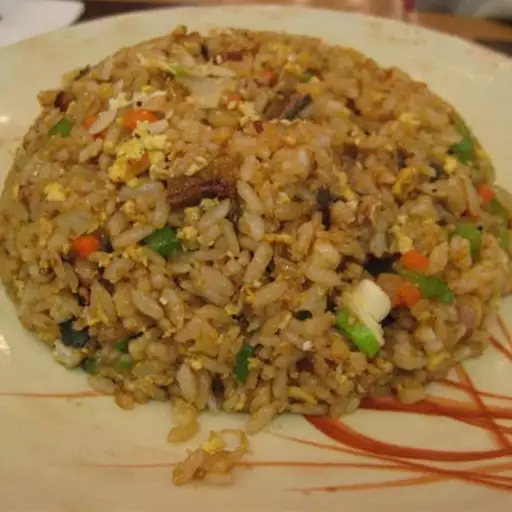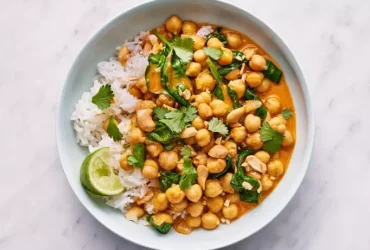Choosing the Right Ingredients
Select High-Quality Rice
- Selecting the right ingredients for Easy Japanese Fried Rice is crucial to achieving a delicious and authentic flavor.
- For this dish, we need high-quality rice as the base ingredient.
Select High-Quality Rice
We recommend using short-grain Japanese rice, also known as Sushi Rice, which is specifically designed to hold its shape and have a sticky texture when cooked. This type of rice is ideal for fried rice dishes as it will not fall apart or become mushy.
Some popular varieties of Japanese rice include:
- Koshihikari
- Nihonbare
- Akitakomachi
When selecting your Japanese rice, make sure to choose a brand that is known for its quality and freshness. You can often find these varieties at Asian grocery stores or online.
Avoid using regular long-grain rice, as it will not hold up well in the frying process and may become dry and crumbly.
Other Essential Ingredients
In addition to high-quality rice, we also recommend the following essential ingredients for Easy Japanese Fried Rice:
- Furikake: a Japanese seasoning blend that typically includes seaweed, sesame seeds, and spices. This will add depth and umami flavor to your fried rice.
- Scallions: thinly sliced or chopped scallions will add a fresh and oniony flavor to your dish.
- Soy Sauce: a salty and savory condiment that will enhance the overall flavor of your fried rice.
By selecting high-quality ingredients, you will be able to create a delicious and authentic Easy Japanese Fried Rice dish that will impress anyone!
Use Japanese shortgrain rice or calrose rice to achieve the right texture for fried rice.
To achieve the perfect texture for fried rice, it’s essential to choose the right ingredients, particularly when it comes to the type of rice.
The ideal choice for making fried rice is Japanese shortgrain rice or Calrose rice. These types of rice have a higher starch content compared to long-grain rice, which makes them perfect for stir-frying and absorbing flavors.
Japanese shortgrain rice, also known as japonica, has a plumper grain and is more moist than regular long-grain rice. It’s specifically designed to hold its shape after cooking and remains fluffy, making it an excellent choice for fried rice.
Calrose rice, on the other hand, is a medium-grain rice that’s commonly used in Japanese cuisine. It has a slightly firmer texture than shortgrain rice but still retains its moisture well, making it a great option for fried rice.
Why these types of rice are ideal
- The higher starch content helps to create a creamy and tender texture in the finished dish.
- The shorter grain size allows the rice to cook evenly and quickly, preventing it from becoming mushy or overcooked.
- The ability of Japanese shortgrain rice and Calrose rice to retain their moisture helps to prevent the fried rice from drying out, even after cooking.
Tips for choosing the right ingredients
- Look for Japanese shortgrain rice or Calrose rice in your local grocery store. These types of rice are often found in the international or Asian food section.
- Makes sure to check the packaging for the correct type and grade of rice. Japanese shortgrain rice and Calrose rice have distinct characteristics, so it’s essential to choose the right one for your needs.
Using other types of rice
If you don’t have access to Japanese shortgrain rice or Calrose rice, you can still make a decent fried rice with regular long-grain rice. However, keep in mind that the texture and flavor may not be as authentic as using the right type of rice.
Long-grain rice alternatives
- Basmati rice: This type of rice has a distinctive nutty flavor and aroma, but its long grain size can make it prone to breaking when stir-frying. It’s still a good option if you don’t have access to shortgrain or Calrose rice.
- Jasmine rice: Similar to Basmati, Jasmine rice has a fragrant aroma and is known for its soft and fluffy texture. However, it may not hold up as well to stir-frying and may become mushy if overcooked.
What to expect
When using long-grain rice alternatives, you can expect a slightly different texture and flavor in your fried rice. The dish may be more prone to drying out, especially if it’s cooked for too long or at too high a heat.
To minimize the effects of using long-grain rice, make sure to cook the rice until it’s still slightly moist and then stir-fry it with enough oil and seasonings to keep it from becoming dry.
According to a study by the University of California, Davis, short grain rice is stickier and clings together better than long grain rice.
When it comes to making delicious Easy Japanese Fried Rice, choosing the right ingredients is crucial for achieving that perfect balance of flavors and textures.
In this case, we’re specifically focusing on selecting the ideal type of rice to use in our dish.
According to a study by the University of California, Davis, shortgrain rice is stickier and clings together better than longgrain rice, making it an excellent choice for Japanese Fried Rice.
Here are some reasons why you should opt for shortgrain rice:
- Rice texture: Shortgrain rice has a higher starch content compared to longgrain rice, giving it a characteristic stickiness that is essential for the clumping effect in Japanese Fried Rice.
- Flavor absorption: The shortgrain rice’s ability to absorb flavors from other ingredients, such as soy sauce and sesame oil, helps create a more complex taste profile in the dish.
Some popular types of shortgrain rice that you can use for Japanese Fried Rice include:
- Sushi rice (also known as Japanese shortgrain rice): This is a premium variety that is specifically designed to hold together well and have the right balance of stickiness and texture.
- Calrose rice: This is another popular type of shortgrain rice that is widely used in Asian cuisine, including Japanese Fried Rice.
When shopping for rice, look for the following characteristics to ensure you’re getting the right ingredients:
- Highest moisture content: This ensures that the rice will be sticky and clump together well after cooking.
- High starch content: This contributes to the stickiness of the rice and helps it hold its shape in the dish.
In summary, choosing shortgrain rice is essential for making authentic Japanese Fried Rice, as it provides the right texture and flavor profile for this popular Asian dish.
Prepare Other Ingredients
Cooking easy Japanese fried rice is a great way to use up leftover ingredients and create a delicious meal. However, choosing the right ingredients and preparing them properly is crucial for achieving authentic flavors and textures.
To start with, let’s talk about the main ingredients for this dish:
- Japanese short-grain rice: This type of rice is specifically designed to hold its shape after cooking, making it perfect for fried rice. You can use leftover Japanese short-grain rice or cook fresh rice according to package instructions.
- Egg: Whisked eggs are a crucial component of Japanese fried rice, providing moisture and protein. Make sure your eggs are at room temperature before using them.
Vegetables
- Carrots: Diced carrots add sweetness and crunch to the dish.
- Peanuts or cashews: Chopped nuts provide a satisfying texture contrast.
- Mushrooms (optional): Sliced mushrooms, especially shiitake, add an earthy flavor and meaty texture.
Protein
- Diced chicken or pork: Cooked protein adds depth to the dish. Use leftover cooked meat or cook it fresh according to your preference.
- Furikake (optional): A Japanese seasoning blend containing seaweed, sesame seeds, and spices that enhances the umami flavor of the dish.
Now, let’s prepare our ingredients:
- Cook your Japanese short-grain rice according to package instructions. Set aside to cool.
- Dice your carrots and peanuts or cashews into small pieces.
- Slice the mushrooms (if using) into thin strips.
- Whisk your eggs in a bowl, seasoning them with a pinch of salt.
- Cook your protein of choice according to package instructions. Set aside to cool.
Next, let’s move on to preparing the wok or large skillet for cooking:
- Heat a couple of tablespoons of oil in a large wok or skillet over medium-high heat.
- Add diced onions and cook until they are translucent and fragrant, stirring occasionally.
Now that our ingredients are prepared, we’re ready to start cooking our easy Japanese fried rice. Stay tuned for the next section where we’ll discuss the actual cooking process!
Cook chicken, shrimp, and vegetables such as carrots, peas, and green onions in advance to save time while cooking.
To prepare a delicious and authentic Easy Japanese Fried Rice, choosing the right ingredients is crucial.
The foundation of this dish lies in the quality of the rice used. Look for short-grain Japanese rice, such as Koshihikari or Akita Komachi, which holds its shape well when cooked.
For protein sources, you can choose between chicken, shrimp, or a combination of both. Boneless, skinless chicken breast or thighs work well for this recipe, while large shrimp are ideal for adding texture and flavor to the dish.
Select fresh vegetables such as carrots, peas, and green onions. These add natural sweetness and crunch to the Japanese Fried Rice.
Other essential ingredients include:
- Oil or fat: Use a neutral-tasting oil like vegetable or canola oil for sautéing, or opt for sesame oil for added depth of flavor.
- Aromatics: Onions, garlic, and ginger provide the base flavors in Japanese cooking. Choose fresh and aromatic ones to add depth to your dish.
- Seasonings: Soy sauce, sake (or dry white wine), and mirin are staples in Japanese cuisine. Use them to create a savory and slightly sweet flavor profile.
- Flavor enhancers: Optional ingredients like sesame seeds, chopped scallions, or grated daikon radish add texture and visual appeal to your dish.
When cooking chicken, shrimp, and vegetables in advance, keep the following tips in mind:
- Cook the chicken first, then set it aside to prevent it from overcooking when added back into the stir-fry.
- Prepare the vegetables separately by chopping or slicing them uniformly. This ensures even cooking and prevents overcooking of certain ingredients.
- Add aromatics like onions, garlic, and ginger towards the end of cooking to preserve their delicate flavors and textures.
By selecting the right ingredients and cooking in advance, you’ll be well on your way to creating a delicious and authentic Easy Japanese Fried Rice dish that’s sure to impress!
Use fresh ingredients to ensure optimal flavor.
When it comes to making Easy Japanese Fried Rice, choosing the right ingredients is crucial to bring out the authentic flavors and textures that this dish has to offer. One of the most important things to consider when selecting your ingredients is freshness.
The fresher your ingredients are, the more vibrant and flavorful they will be in your finished dish. This holds true for all the components of your fried rice, including the vegetables, meat or seafood, and seasonings.
For vegetables, look for those that are firm to the touch and have no signs of wilting or discoloration. For example, when selecting bell peppers, onions, and carrots, choose ones that are bright in color and smell fresh. Mushrooms should be plump and have a meaty texture.
For the protein component, whether it’s cooked chicken, shrimp, or pork, ensure that it is fully cooked and has no off-odors or flavors. Cooked ingredients can quickly turn stale if not stored properly, so check their freshness before using them in your fried rice.
The seasonings used in Japanese Fried Rice are just as important as the vegetables and protein. Choose a light soy sauce that’s made from fermented soybeans, which gives a rich, savory flavor without overpowering the other ingredients. Wasabi paste adds a pungent kick of heat and pairs well with green onions for added depth.
Other essential seasonings include rice vinegar, sugar, and sesame oil. These components work in harmony to bring balance to the flavors of your fried rice without dominating them. Use high-quality, cold-pressed sesame oil for its rich nutty flavor that complements other ingredients.
Rice itself is another key factor in achieving optimal flavors. Japanese short-grain rice, also known as ‘sushi rice’, has a higher starch content than regular long-grain rice. This allows it to hold its shape and separate well after cooking, making it ideal for dishes like Easy Japanese Fried Rice.
Lastly, don’t forget about the egg in your fried rice recipe! A lightly beaten egg serves as a binding agent that helps tie all the ingredients together while adding creaminess.
Cooking Techniques
Heat Control is Key
Cooking techniques play a vital role in creating delicious dishes like Easy Japanese Fried Rice, and one of the most essential aspects of cooking is heat control.
Heat control refers to the ability to manage and regulate the temperature of your cooking environment to achieve the desired doneness or texture of your ingredients.
In the case of Easy Japanese Fried Rice, mastering heat control is crucial because it allows you to quickly cook the ingredients without overcooking them or creating a burnt flavor.
To successfully cook Easy Japanese Fried Rice, you should start by preheating a large skillet or wok over medium-high heat. This will allow you to quickly add your oil and aromatics, such as garlic and ginger, which are essential for adding depth of flavor to your dish.
Once the oil is hot and fragrant, add your protein and vegetables, stirring constantly to prevent them from burning or sticking to the pan.
Next, add your cooked rice, breaking up any clumps with a spatula as you stir-fry it. This will help to distribute the flavors evenly throughout the dish and create a smooth, uniform texture.
The key to success in Easy Japanese Fried Rice is to cook everything quickly over high heat, using a combination of stirring and tossing to ensure that all of the ingredients are cooked through.
However, if you’re not careful, it’s easy to burn your rice or create a dish that’s too greasy. To avoid this, make sure to adjust your heat as needed to prevent burning or overcooking.
One technique for achieving perfect heat control in Easy Japanese Fried Rice is to use the “wok hei” method, which involves creating a high-heat environment by adding oil and stir-frying the ingredients quickly. This will help to create a flavorful, caramelized crust on your rice that’s characteristic of traditional Japanese fried rice.
Another technique for mastering heat control in Easy Japanese Fried Rice is to use a thermometer to monitor the temperature of your pan. By keeping your pan between 325-375 degrees Fahrenheit, you can ensure that your ingredients are cooked at a consistent, high heat.
In summary, heat control is a critical aspect of cooking Easy Japanese Fried Rice, and mastering this technique will allow you to create a delicious, restaurant-quality dish in the comfort of your own home.
Fry rice over mediumhigh heat to achieve a crispy texture on the bottom.
To cook fried rice with a crispy texture on the bottom, it’s essential to master the technique of pan-frying, specifically using medium-high heat.
The first step is to prepare your wok or large skillet for frying by adding a small amount of oil. Choose an oil with a high smoke point, such as vegetable or peanut oil, which can handle the high heat without breaking down or smoking.
Next, add a sufficient amount of rice to the pan. The ideal ratio is about 2 cups of cooked rice per serving, but feel free to adjust according to your preference and serving size. Use leftover or day-old rice for this recipe, as it’s drier and easier to separate into individual grains.
Now, place the pan over medium-high heat, ensuring that the oil starts to shimmer and slightly smoke before adding the rice. This initial high heat helps create a crispy crust on the bottom of the pan, known as the ‘okoge’ in Japanese cuisine.
Once you add the cooked rice to the pan, spread it evenly with a spatula or spoon to cover the entire surface. As the rice cooks, gently stir-fry it by breaking up any clumps and spreading the grains apart.
The goal is to create a uniform texture throughout while maintaining the crispy bottom layer. You can achieve this by stirring occasionally and using a gentle folding motion with your spatula or spoon.
It’s crucial not to overcrowd the pan, as this will prevent the rice from cooking evenly and making it challenging to achieve the desired crusty bottom. Cook in batches if necessary, but keep in mind that the more you cook at once, the harder it is to achieve a perfectly crispy texture on all cooked portions.
To ensure the bottom layer of the fried rice remains crispy, avoid stirring it excessively throughout the cooking process. This might break up or distribute the crusty particles too much, leaving them dispersed within the dish instead of maintaining their distinct crunchy texture on top.
Monitor the temperature and adjust as necessary to prevent burning, which can happen quickly at high heat levels. If you notice any areas turning dark brown or developing a smoky smell, reduce the heat immediately.
To finish, garnish with your choice of ingredients, such as green onions, soy sauce, or pickled ginger, to enhance both flavor and presentation.
The United States Department of Agriculture recommends frying food at temperatures between 325°F and 375°F (165°C and 190°C) for optimal browning.
The art of cooking techniques is a crucial aspect of preparing delicious meals, and when it comes to easy Japanese fried rice, understanding the basics of frying food is essential.
Frying is a cooking technique that involves partially submerging food in hot oil or fat until cooked through. Temperature control is critical when it comes to frying, as it can make or break the dish. The United States Department of Agriculture recommends frying food at temperatures between 325°F and 375°F (165°C and 190°C) for optimal browning.
The reason behind this temperature range lies in the Maillard reaction, a chemical reaction between amino acids and reducing sugars that occurs when food is cooked, resulting in the formation of new flavor compounds and browning. If the oil is too hot, it can burn the outside of the food before cooking the inside, leading to an unpleasant texture and flavor.
When frying food for easy Japanese fried rice, it’s essential to use a wok or large skillet with a heavy bottom, as this allows for even heat distribution. Add a small amount of oil to the pan and swirl it around to coat the surface before adding the aromatics, such as garlic and ginger.
Once the aromatics are fragrant, add the cooked rice to the pan, breaking up any clumps with a spatula. Stir-fry the rice for about 5-7 minutes, until it’s heated through and starting to brown. This is where the magic happens, as the rice absorbs all the flavors from the pan.
As you continue to stir-fry the rice, add your desired protein, vegetables, and seasonings, such as scrambled eggs, diced vegetables, and soy sauce. The key to making easy Japanese fried rice is to cook everything in one wok or skillet, allowing all the flavors to meld together.
The final step is to serve the fried rice hot, garnished with green onions and a squeeze of fresh lime juice. This technique may seem simple, but it’s a game-changer for anyone looking to master the art of easy Japanese fried rice.
Add Seasonings and Stir-Fry
Cooking techniques play a crucial role in creating delicious and well-balanced dishes like Easy Japanese Fried Rice. One essential technique is stir-frying, which involves quickly cooking ingredients over high heat while continuously stirring them. This method helps to preserve the texture, flavor, and color of the ingredients, making it perfect for fried rice recipes.
Another key aspect of cooking techniques in this recipe is the use of seasonings. In Japanese cuisine, seasonings like soy sauce, sake, and mirin are commonly used to add depth and umami flavor to dishes. To incorporate these seasonings effectively, cooks should aim to balance their usage with other ingredients in the dish. This ensures that each component contributes to the overall harmony of flavors without overpowering the others.
When it comes to stir-frying, proper technique is essential for achieving a perfectly cooked and evenly seasoned fried rice. Start by heating your wok or large skillet over medium-high heat, then add oil and swirl it around to coat the pan. This step helps prevent ingredients from sticking and promotes smooth cooking.
Next, add aromatics like onions, ginger, and garlic and stir-fry them until fragrant and softened. This initial cooking phase is critical in developing the base flavors of your dish. Be sure not to burn these aromatic ingredients by adding too much heat or cooking for too long.
After preparing the aromatics, add protein (such as cooked chicken or shrimp) and stir-fry until it’s heated through. Then, incorporate pre-cooked rice into the wok or skillet, followed by any desired vegetables, such as peas, carrots, and green onions. Stir constantly to avoid overcooking the ingredients.
Now is the time to add seasonings like soy sauce, sake, and mirin according to your taste preferences. Combine these components with a small amount of water or broth, stirring continuously, until everything has absorbed evenly into the rice mixture. Season as needed to achieve the perfect balance of flavors.
To finish the dish, garnish with green onions and serve immediately. By mastering these techniques and incorporating essential seasonings like soy sauce, sake, and mirin, you’ll be able to create a mouthwatering Easy Japanese Fried Rice that is both flavorful and visually appealing.
Add soy sauce, oyster sauce, and sesame oil to give the dish flavor.
Cooking techniques play a vital role in creating delicious and authentic dishes, such as Easy Japanese Fried Rice.
To begin with, let’s explore some fundamental cooking techniques that are essential for preparing this dish:
- Stir-frying: This technique involves quickly stir-frying ingredients in a wok or large skillet over high heat. It helps to preserve the color and texture of the ingredients while creating a harmonious balance of flavors.
- Marinating: Marinating involves soaking ingredients in a mixture of seasonings, oils, and acids to enhance their flavor and texture. This step is crucial for adding depth and umami flavor to the dish.
- Wok-searing: Wok-searing involves cooking ingredients in a wok or large skillet with some oil over high heat, stirring constantly to prevent burning. This technique helps to create a caramelized crust on the ingredients while locking in their natural flavors.
When it comes to adding flavor to Easy Japanese Fried Rice, three key condiments come into play:
- Soy sauce: A staple in Japanese cuisine, soy sauce is a fermented soybean paste that adds depth, umami flavor, and rich color to the dish.
- Oyster sauce: This savory sauce is made from oyster extract, sugar, and water. It adds an intense umami flavor and is often used as a seasoning in stir-fry dishes.
- Sesame oil: This fragrant oil has a distinct nutty aroma and is often used to add depth and warmth to the dish. It can be applied at the end of cooking to prevent its delicate flavors from burning or evaporating.
To incorporate these condiments into your Easy Japanese Fried Rice, follow these steps:
- Heat a tablespoon of sesame oil in a wok or large skillet over high heat. Add diced vegetables, such as carrots and green onions, and stir-fry until they are tender.
- Add cooked rice to the wok or skillet and stir-fry for 2-3 minutes, breaking up any clumps with a spatula.
- In a small bowl, whisk together soy sauce and oyster sauce. Pour this mixture over the rice and vegetables in the wok, stirring constantly to prevent the sauces from burning.
- Taste the dish and adjust seasoning as needed, adding more soy sauce, oyster sauce, or sesame oil to your liking.
- With these techniques and condiments combined, you can create an authentic Easy Japanese Fried Rice that is both delicious and visually appealing.
Stirfry all ingredients together until well combined.
In the process of preparing Easy Japanese Fried Rice, a key step involves combining all ingredients together through the technique of stir-frying.
Cooking Techniques for Stir-Frying in Easy Japanese Fried Rice
- Choose the Right Wok or Pan: A large, deep wok or frying pan with a non-stick coating is ideal for stir-frying. This prevents ingredients from sticking and makes cleanup easier.
- Heat the Oil: Heat about 1-2 tablespoons of oil in your wok or pan over high heat until it starts to smoke. This indicates that the oil has reached its smoking point, making it perfect for stir-frying.
- Add Aromatics: Add your aromatics such as diced onions, minced garlic, and grated ginger. Stir-fry these ingredients quickly to release their flavors and aroma.
- Add Proteins (if using): If you’re adding proteins like cooked chicken, beef, or shrimp, stir-fry them along with the aromatics until they’re coated with the oil and heated through.
- Add Cooked Rice: Stir in your cooked rice. Make sure to break up any clumps with a spatula so that the rice cooks evenly.
- Add Seasonings and Vegetables (if using): Add soy sauce, sake or mirin, sugar, salt, and any other desired seasonings. Stir-fry for about 2-3 minutes to allow the flavors to meld together. Then add your vegetables like peas, carrots, and green onions, if using.
- Stir-Fry until Well Combined: Continue stir-frying all ingredients together until they’re well combined, heated through, and the rice is evenly coated with the sauce. This should take about 5-7 minutes, depending on your heat level and the number of ingredients.
The result should be a delicious and savory Easy Japanese Fried Rice dish that’s perfect for any meal or occasion!
Serving Suggestions
Present with Flair
To elevate your Easy Japanese Fried Rice to a new level, consider these serving suggestions that will surely impress your dinner guests:
Presentation is everything, and with a few simple steps, you can transform this humble dish into an artistic feast for the eyes.
Garnish with Fresh Herbs: Sprinkle a pinch of chopped scallions or cilantro over the top of your fried rice to add a pop of color and freshness. This will not only make it visually appealing but also add a burst of flavor.
Use a Sushi-Grade Fish Slice as a garnish: Place a thin slice of sesame-crusted salmon or tuna on top of the rice for an extra touch of elegance.
Create a Colorful Pattern: Arrange the fried rice in a circular pattern, creating a visual contrast with the bright colors of the herbs and fish. This will add depth to your dish and make it Instagram-worthy.
Add some Toasted Sesame Seeds on top: Sprinkle a pinch of toasted sesame seeds over the rice for added texture and nutty flavor.
Serve in Small, Delicate Bowls: Transfer the fried rice into small, delicate bowls or ramekins to create an intimate dining experience. This will make each serving feel like a special treat.
Finally, don’t forget to add a side of Pickled Ginger or wasabi to complement your dish and provide a bold contrast in flavor.
With these simple yet effective serving suggestions, you’ll be able to transform your Easy Japanese Fried Rice into an exquisite culinary experience that will delight the senses.
Serve fried rice in a bowl or on a platter garnished with green onions and sesame seeds.
To add an authentic touch to your Easy Japanese Fried Rice, consider presenting it in a way that is reminiscent of traditional Japanese cuisine.
Serve the dish in a bowl or on a platter, garnished with thinly sliced green onions and toasted sesame seeds. The vibrant color and delicate flavor of these toppings will add a pop of freshness to each bite and complement the savory flavors of the fried rice.
For an added layer of visual appeal, consider arranging the green onions in a fancy pattern or design on top of the dish. This could be as simple as creating a small spiral or as intricate as a stylized floral motif.
To make the most of this presentation, serve your Easy Japanese Fried Rice hot, straight from the wok or frying pan. The aroma of sizzling ingredients and toasted sesame seeds will tantalize the senses and leave everyone eager to dig in.
According to a study by the Japanese Ministry of Agriculture, Forestry, and Fisheries, presentation is an important aspect of Japanese cuisine.
In traditional Japanese culture, presentation is considered a vital component of enjoying any meal, including a simple yet delicious dish like Easy Japanese Fried Rice.
The presentation style can greatly enhance the overall dining experience and is often determined by the type of occasion or event. For a casual gathering with friends and family, a more relaxed approach to serving may be suitable.
In Japan, it’s common for food to be arranged in visually appealing patterns on the banquette. This attention to detail reflects an emphasis on aesthetics in Japanese cuisine.
To make your Easy Japanese Fried Rice even more impressive, consider adding garnishes that add color and texture. Fresh herbs like scallions or basil can be used as a fragrant finishing touch, while sesame seeds or grated daikon radish can provide a pop of flavor.
A small bowl or ramekin filled with pickled ginger, gari, is another popular garnish in Japanese cuisine. It adds a burst of acidity and helps balance the flavors on the palate.
To add an extra layer of flavor to your Easy Japanese Fried Rice, try using takoyaki sauce or a combination of soy sauce, sake, and mirin as a finishing glaze. These options will complement the savory flavors of the dish while enhancing its overall umami taste.
In Japan, food is often served in small portions to promote mindful eating and social interaction. When serving Easy Japanese Fried Rice, consider portioning it into smaller bowls or ramekins, allowing each guest to serve themselves and enjoy at their own pace.
To elevate the presentation of your Easy Japanese Fried Rice, think about incorporating other elements that reflect traditional Japanese aesthetics. A small bowl of miso soup, a side salad with pickled vegetables, or a simple fruit platter can all add to the visual appeal and variety of the meal.
In Japan, the emphasis on presentation extends beyond food itself to include the overall dining experience. By considering these elements when serving Easy Japanese Fried Rice, you can create an enjoyable atmosphere for your guests and showcase the beauty of this simple yet delicious dish in a whole new way.
- Best Clay Alternatives for 2025 - April 22, 2025
- Best Leadfeeder Alternatives for 2025 - April 22, 2025
- Best Snov.io Alternatives for 2025 - April 21, 2025













